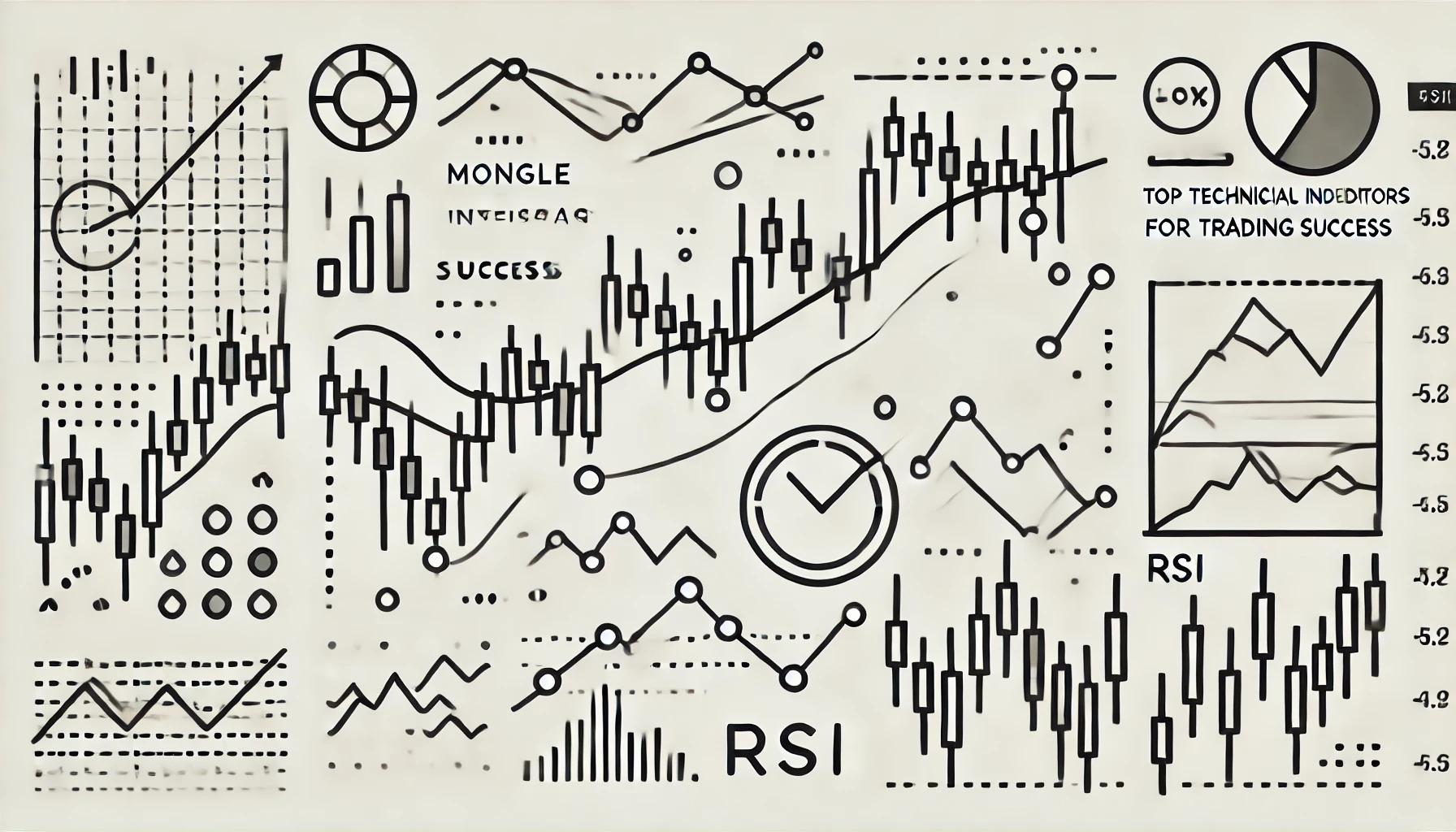Your cart is currently empty!
Top Technical Indicators for Trading Success

Technical analysis is an essential tool for traders looking to make informed decisions in the financial markets. By using various indicators, traders can better predict price movements and maximize profitability. Technical indicators are quantitative tools that analyze past price data, volume, and trends to help traders identify potential trading opportunities. This article will explore some of the most popular technical indicators that are considered vital for achieving trading success. Whether you are a beginner or an experienced trader, understanding these indicators can help sharpen your trading skills and improve your decision-making process.
1. Moving Averages (MA)
Moving Averages are among the simplest yet most effective indicators used by traders globally. A Moving Average is a line that smoothens price action, providing a clearer picture of a market’s trend by filtering out short-term fluctuations. There are two primary types of Moving Averages: the Simple Moving Average (SMA) and the Exponential Moving Average (EMA). The SMA calculates the average price over a set period, while the EMA gives more weight to recent data, making it more sensitive to price changes.
Traders use Moving Averages to determine support and resistance levels, as well as to identify trend directions. The crossing of shorter-term and longer-term MAs is often used as a signal to enter or exit a position. For example, when a 50-day MA crosses above a 200-day MA, it is seen as a bullish signal, commonly known as a “Golden Cross.” Conversely, a “Death Cross” occurs when the shorter-term MA crosses below the longer-term MA, signaling a bearish outlook.
2. Relative Strength Index (RSI)
The Relative Strength Index (RSI) is a momentum oscillator that measures the speed and change of price movements. RSI is typically used to identify overbought or oversold conditions in the market. It ranges from 0 to 100, with values above 70 indicating an overbought market and values below 30 indicating an oversold market.
Traders use RSI to spot potential reversal points. For example, if an asset reaches an RSI value above 70, traders may anticipate a reversal and consider selling or taking profits. Conversely, if the RSI drops below 30, it may indicate a buying opportunity. RSI can also be used to detect divergences, which occur when the price moves in the opposite direction of the indicator, signaling potential trend reversals.
3. Moving Average Convergence Divergence (MACD)
The Moving Average Convergence Divergence (MACD) is a trend-following momentum indicator that shows the relationship between two moving averages of an asset’s price. The MACD is calculated by subtracting the 26-period EMA from the 12-period EMA, and it is often displayed with a nine-day EMA called the “signal line.”
When the MACD crosses above the signal line, it is considered a bullish signal, indicating that it may be time to buy. Conversely, when the MACD crosses below the signal line, it suggests a bearish signal. Additionally, the histogram, which represents the difference between the MACD line and the signal line, can help traders gauge the strength of the trend.
MACD is especially useful in identifying changes in the strength, direction, and duration of a trend, making it a popular tool among traders who prefer to follow market trends closely.
4. Bollinger Bands
Bollinger Bands are volatility indicators that consist of a middle band (typically a 20-day SMA) and two outer bands that represent standard deviations away from the middle band. These bands expand and contract based on market volatility, providing traders with a visual representation of how much the price is deviating from its average.
Bollinger Bands helps traders identify overbought or oversold conditions and anticipate potential price reversals. When the price moves closer to the upper band, the asset may be overbought, while a move toward the lower band suggests that it may be oversold. Traders also use Bollinger Bands to spot “squeezes,” which occur when the bands contract, indicating that a breakout is imminent.
5. Fibonacci Retracement
Fibonacci Retracement is a popular technical analysis tool used to identify potential support and resistance levels by measuring the retracement of an asset’s price movement. It is based on the Fibonacci sequence, and the key retracement levels used are 23.6%, 38.2%, 50%, 61.8%, and 78.6%.
Traders use Fibonacci retracement levels to identify potential entry points during pullbacks in an existing trend. For instance, if an asset is trending upwards, traders may wait for it to retrace to one of the Fibonacci levels before initiating a long position. These levels are considered areas where price action is likely to stall or reverse, making them effective tools for planning trades.
6. Stochastic Oscillator
The Stochastic Oscillator is another momentum indicator used to compare an asset’s closing price to its price range over a given period. Like RSI, the Stochastic Oscillator ranges from 0 to 100, and it is used to identify overbought and oversold conditions. A reading above 80 suggests that the asset is overbought, while a reading below 20 indicates that it may be oversold.
Traders use the Stochastic Oscillator to identify potential reversal points and determine the strength of a trend. When the %K line crosses above the %D line, it is considered a bullish signal, whereas a cross below the %D line is a bearish signal.
7. Average Directional Index (ADX)
The Average Directional Index (ADX) is a trend strength indicator that helps traders determine whether a market is trending or ranging. ADX is represented on a scale of 0 to 100, with values above 25 indicating a strong trend and values below 20 suggesting a weak or non-existent trend.
Traders use ADX to assess the strength of a trend rather than its direction. A rising ADX indicates that the trend is gaining strength, while a falling ADX indicates a weakening trend. By combining ADX with other indicators, traders can improve their understanding of market conditions and make more informed trading decisions.
8. Ichimoku Cloud
The Ichimoku Cloud is a versatile indicator that provides a comprehensive view of an asset’s price action by incorporating multiple elements, including trend, support and resistance, and momentum. The cloud itself is formed by two lines, known as the Senkou Span A and Senkou Span B, and helps traders identify the direction of the trend.
When the price is above the cloud, it suggests a bullish trend, while a price below the cloud indicates a bearish trend. The Ichimoku Cloud also helps identify potential support and resistance levels, making it an all-in-one indicator for traders seeking a holistic view of the market.
9. Volume Indicators
Volume indicators are crucial for understanding the level of participation behind price movements. One popular volume indicator is the On-Balance-Volume (OBV), which measures cumulative buying and selling pressure. By analyzing volume, traders can determine whether a trend is backed by sufficient momentum or if it is likely to reverse.
Volume indicators help confirm price trends and indicate the strength of market moves. For example, if an asset is experiencing an upward price movement accompanied by high volume, it suggests that the trend is supported by strong buying interest. Conversely, a price movement with low volume may indicate a lack of conviction, potentially signaling a reversal.
10. Conclusion: Mastering Technical Indicators for Success
Incorporating technical indicators into your trading strategy can significantly improve your ability to make well-informed trading decisions. Moving Averages, RSI, MACD, Bollinger Bands, Fibonacci Retracement, and other indicators discussed in this article are all powerful tools that provide valuable insights into market behavior.
However, no single indicator can guarantee trading success, and it is crucial to use a combination of indicators to confirm signals and reduce the likelihood of false predictions. Furthermore, understanding the limitations of each indicator and using them in conjunction with proper risk management strategies is vital to becoming a successful trader.
As you continue your journey in trading, experimenting with different indicators and finding the ones that work best for your trading style will help you develop a robust and reliable trading plan. By doing so, you’ll be better equipped to navigate the complexities of the financial markets and achieve your trading goals.

Mr. Rajeev Prakash
Rajeev is a well-known astrologer based in central India who has a deep understanding of both personal and mundane astrology. His team has been closely monitoring the movements of various global financial markets, including equities, precious metals, currency pairs, yields, and treasury bonds.

